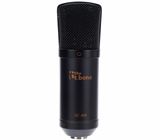To give you a bit of an introduction, I've been working in broadcasting for 27 years. This is my first full-range, studio-use condenser microphone; though I've used some that weren't my own. I've owned and used dynamic microphones pretty much all my life. I've used some good and some bad; some dirt cheap, and some at the top of the price list for their purpose. The expensive ones weren't always the best, but at the same time, the cheap ones weren't always the best, either.
My voice has a very de-nasal bump right around 800Hz, and between the frequency response of those mics and the ability I (or whoever's engineering) have to EQ them with whatever they're plugged into, it can be very hard to make them sound like my unamplified voice does to the average ear. In fact, the microphone that I had plugged in to my chain before I received the SC 400 required TWO bands on my parametric EQ to be set to 800Hz and cranked WAY down.
I plugged in the t.bone SC 400 and reset my entire EQ to zero. I was prepared to test it out as long as it took to get it right.
It took thirty seconds.
All I need is one band at 800Hz turned down to about 25%, and this things sounds BEAUTIFUL. Crisp highs -- I actually had to back those down a little, too, but not by much -- perfect low end, not a single other thing adjusted to compensate. Never in my life has it been that simple. The SC 400 sounds very natural, it's very sensitive, and I have been thoroughly enjoying every moment with it.
I'm using it for home voiceover recording and, eventually, podcasting and radio. In fact, as I type this, I just moments ago ordered a mixer and audio interface right here at Thomann in preparation for that.
I don't have any "cons" to give you, but as many people seem to be buying this as an entry-level studio condenser (as I did) and likely need some help adjusting, let me give you a couple of notes:
Sensitivity is going to be the first thing you notice, because the SC 400 has plenty of it. If you're not familiar with how to read sensitivity figures for microphones, I'll just give you the basic idea: where you see "dB re 1V/PA," the higher the number in that spec, the more sensitive the microphone is. The SC 400 is rated at -32.6 dB in that category. One of my other microphones, the Audio-Technica PRO 61 (a dynamic), is rated at -55 dB in that category. If I switch back and forth between the two, my preamp will have to be significantly adjusted to compensate.
The SC 400 is a hypercardioid microphone, meaning the most sensitive, accurate-sounding area around it is dead-center, right in front of the diaphragm. If you move around your microphone a lot, you're going to find yourself off-axis and sounding distant rather often. This mic is generally intended for studio situations where you or your talent are stationary in front of it (such as vocal recordings or radio broadcasts). This attribute COULD be used in a live sound setting to avoid feedback, but don't forget about that sensitivity, because even if it's off-axis, it WILL still pick up sounds from all around you. In ANY setting, I highly recommend a noise gate.
Being a condenser, the SC 400 is meant to be used at a slight distance away from the mouth. You don't want to eat this microphone, it will not do you any favors. Now, that said, I do personally keep it closer to my face, but I also keep it slightly off to the side so that the front of the diaphragm IS still pointed at my mouth, but the direct wind from my speech is passing over the TOP of the mic, not directly into it. This prevents plosives while still providing the proximity effect. In fact, I recommend that technique with ANY microphone. Old trick of the trade that seems to have been lost over the years.
Bottom line: just buy this microphone. You will not regret it.


